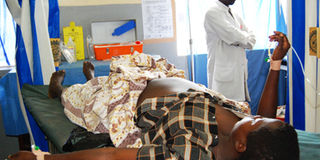Prime
Maternal deaths can be controlled

A doctor attends to an expectant mother at Mbarara Hospital. PHOTO BY STEPHEN WANDERA OJUMBO.
Prior to a mother’s death before, during and after delivery, there are warning signs that she is not well. If mothers and medical personnel respond immediately, maternal deaths can be prevented, writes Sarah Tumwebaze.
Mary Nambi had always delivered from recognised health centres with the help of trained nurses and doctors. However, the day she delivered her sixth and last born, she was in the village and it was late in the night. During that time, the health facility is closed. The elderly women who were with her decided to help her deliver. She gave birth to a bouncing baby boy but the placenta did not come out after delivery and she was going through a lot of pain.
One of the women said that the only way they could deliver the ‘after birth’ was by just pulling it out. The moment they pulled it, Nambi started bleeding and she did not stop until she died in the wee hours of the morning.
Most women who have given birth say that the time of delivering the baby is a matter of death and life. According to Dr Mike N. Kagawa a lecturer in Obstetrics and Gynaecology at Mulago National Referal Hospital, for any woman who dies during pregnancy or delivery or within 42 days after delivery regardless of the duration of the pregnancy and its location, this is referred to as maternal death.
He says that there are different reasons why women die during and after pregnancy. “The causes of maternal death are divided into two; direct and indirect causes.” Dr Kagawa says that in Uganda, some of the direct causes of maternal death are bleeding, hypertension, obstructed labour, sepsis (infections) and abortion complications.
Ms Sakina Kiggundu the President of the Uganda Private Midwives Association says that bleeding which is also referred to as postpartum haemorrhage contributes to 25 per cent of the death of women during and after delivery. She explains that after giving birth, a woman might bleed a little but in some cases, some bleed more than others and if there is no immediate intervention, such a mother will become anaemic, go into shock and then die just like Nambi.
Besides bleeding, mothers can also die from infections or sepsis during delivery and these contribute to 15 per cent of maternal deaths. “The infections are mainly caused by delayed delivery and the use of unclean instruments during delivery and abortion because the immunity of a pregnant woman is very low so she can easily get infected,” explains Ms Kiggundu.
Sakina adds that some mothers normally have hypertensive disorders but are not aware. So during the time of delivery, they develop high blood pressure which affects the blood flow by making vessels constricted and when this occurs, the oxygen supply is limited leading to the 12 per cent of maternal deaths.
Unsafe abortions which are done by unskilled people who use unprofessional methods like hooks, herbs plus unclean instruments contribute to 13 per cent of these deaths.
Mr Patrick Bateganya the General Secretary for the Uganda Nurses and Midwives Union says that, “Some mothers take herbs which make the uterus react strongly and since there is no one to tell them when to stop taking them, such herbs have a high concentration in the body and thus weaken the uterus so at the time of giving birth, the uterus might burst and the mother ends up bleeding to death. In some cases, the baby might also die.”
He adds that other times, the woman giving birth might have had many children (five to six) and by the time they give birth to either the fifth or sixth child, the uterus can no longer contract so this may lead to bleeding to death.
Bateganya says that the least direct causes of martenal deaths are obstructed labour and ectopic pregnancies because they contribute to eight per cent of deaths. “Obstructed labour is a situation where the mother stays in labour for more than 24 hours because the baby is either too big to go through the cervix or its lying in a wrong position and ectopic pregnancies occur when the feotus starts growing outside the uterus.”
Ms Kiggundu says that the indirect causes like malaria, HIV/Aids, tuberculosis and traditional birth attendants contibute the remaining 27 per cent of the maternal deaths in Uganda.
However, it’s not like these mothers just drop and die without any warning. Dr Kagawa says that there are always danger signs during pregnancy and at the time of labour that the mother might not make it. “During pregnancy, when a woman starts developing signs like excessive body swelling, head ache, getting tired easily, bleeding, fever, severe abdominal pains, fast breathing, skin lightening and convulsions, it’s a sign that they do not have enough blood or they have malaria and failure to intervene immediately, might lead to the passing away of such a mother during pregnancy or at the time of delivery or even after giving birth,” he says.
During labour, the mother will show signs like taking long to deliver (more than 24 hours), continuous pains because labour pains should come in intervals, bleeding during delivery which might imply that the uterus has ruptured and the woman is bleeding inside, weakness, convulsions and becoming uncooperative. “All these signs might imply that the woman is either tired, has a narrow pelvis, her uterus has ruptured or the baby is not in the right position. So such a mother should have a caesarian section immediately,” he explains.
Dr Kagawa says there are three major contributing factors to these deaths which are referred to as delays. “Delay to recognise the problem and seek medical care like in cases where the mother notices that she is bleeding but does not bother to go and see the doctor. Delay in reaching the health facility because of poor roads or lack of transport and delay by the health workers to intervene and do something either because they are not around, lack of technical knowledge or lack of support by the system like drugs and an ambulance.”
Although it’s hard to predict what might happen to a mother during and after pregnancy plus at the time of birth, the gynaecologist says that maternal deaths can be controlled if the three delays are addressed. He therefore advises that the moment any mother realises that they are pregnant; they should go for antenatal care because in this way, the doctors and midwives will be able to rule out any complications like hypertensive disorders, anaemia and malaria which might lead to death.
Mothers should always look out for danger signs during pregnancy and during the time of delivery, doctors and midwives should always look out for the danger signs. Ms Kiggundu adds that government should provide health facilities like ambulances, drugs and equipments. “They should also train more midwives to help at the time of delivery and mothers should never go to a traditional birth attendant for delivery because these people do not have the expertise.”
If all expectant mothers attend antenatal care, always look out for danger signs and seek the help of trained medical personnel, the percentage of maternal deaths in the country will be lowered and we shall not lose mothers like Nambi.




